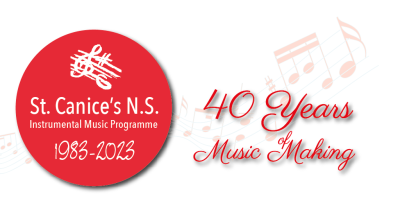In Third Class Violin and Cello players may wish to continue their playing by taking part in our Third Class lessons. These lessons involve preparation for our Junior Orchestra pieces. Third Class wind players may also join Canice’s Cubs once they have grasped their instrument. If they haven’t already taken up an instrument or wish to try something else they can take up Viola, Double Bass, Recorder, Pocket Trumpet, Trumpet, Trombone, French Horn, Baritone, Saxophone, Clarinet, Piccolo or Flute. If numbers permit those second class students with lots of rhythm can continue with Senior Percussion lessons! If they are a singer now may be the time to enrol them in singing lessons. Perhaps they are interested in the piano either? Most of our Third Class instrumentalists, who have already taken their Preparatory theory exam also benefit from enrolling in our Royal Irish Academy of Music Grade 1 Theory classes which augment and supplement their instrument learning and will go on to take a theory exam in May.
In Fourth Class our more experienced instrumentalists move up to the Senior Orchestra and those who have only newly taken up instruments may be involved in B Orchestra with wind and brass players joining Junior Jazz Band too. Those who haven’t already taken up one of our many instruments (as above, not forgetting singing and piano too) can do so this year, or those that have may wish to try something new! Guitar lessons are also available (guitars unfortunately are not available for hire from the music programme). Most of our Fourth Class instrumentalists, who have already taken their Grade 1 theory exam also benefit from enrolling in our Royal Irish Academy of Music Grade 2 Theory classes which augment and supplement their instrument learning and will go on to take a theory exam in May.
In Fifth Class our more experienced instrumentalists move up to the Senior Orchestra and those who have only newly taken up instruments may be involved in B Orchestra with wind and brass players joining Jazz Band too. Those who haven’t already taken up one of our many instruments (as above, not forgetting singing and piano too) can do so this year, or those that have may wish to try something new! Guitar lessons are also available (guitars unfortunately are not available for hire from the music programme). Most of our Fifth Class instrumentalists, who have already taken their Grade 2 theory exam also benefit from enrolling in our Royal Irish Academy of Music Grade 3 Theory classes which augment and supplement their instrument learning and will go on to take a theory exam in May.
Sixth Class musicians continue playing and enjoying their instruments in A Orchestra and Jazz Band and it’s never too late to try a new instrument, not forgetting the Guitar, Piano or Singing. They show their skills in the Sixth Class Farewell where they have an opportunity to perform on an instrument of their choice before their parents. A fabulous evening enjoyed by all!
